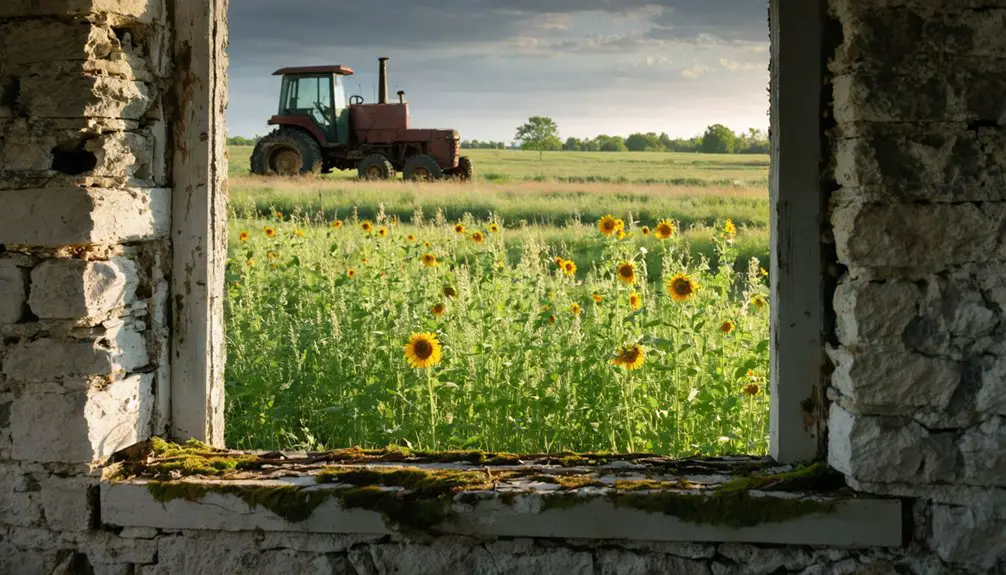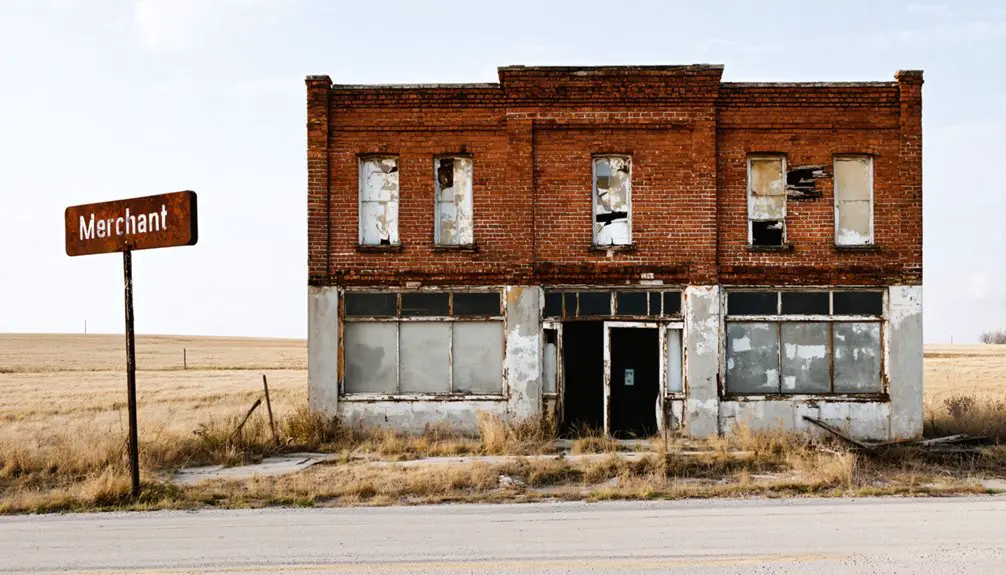You’ll find Farlington’s ghost town remains along the historic Kansas City, Fort Scott & Gulf Railroad line in Crawford County, Kansas. Founded in 1869, this once-bustling community thrived on coal mining and Swedish immigrant labor, producing over half of Kansas’s coal by the early 1900s. While the town declined after mine closures, you can still explore Swan Lake, a 100-acre reservoir built in 1937, and the historic catalpa forest that tells a deeper story of railroad innovation.
Key Takeaways
- Farlington was established in 1869 along the Kansas City, Fort Scott & Gulf Railroad and thrived as a coal mining and shipping hub.
- The town’s economy peaked in the 1880s through coal production, railroad operations, and timber production from catalpa plantations.
- Swan Lake, a 100-acre artificial reservoir built in 1937, remains a notable landmark of Farlington’s railroad and agricultural past.
- The closure of local coal mines and declining railroad importance led to Farlington’s economic downturn and eventual ghost town status.
- Historical preservation efforts focus on maintaining the old depot and catalpa grove as reminders of Farlington’s industrial heritage.
The Birth of a Railroad Town (1869)
As the Kansas City, Fort Scott & Gulf Railroad expanded westward in 1869, the new settlement of Farlington emerged along its tracks in southeastern Kansas.
You’ll find that the railroad company’s vision shaped every aspect of the town, from the strategic planting of hundreds of acres of catalpa trees to the creation of a 100-acre artificial lake for locomotive water needs.
Initially called “The Tank” and briefly Farleyville, the town quickly attracted Swedish immigrants who found work in nearby coal mines.
By 1873, you could witness the growing community’s commitment to local governance with the construction of their town hall.
The establishment of Eugene D. Farley’s post office in 1870 marked another milestone in Farlington’s development as a bustling railroad hub with promise and potential.
A section house was built to accommodate the railroad workers who maintained the tracks.
The town’s economy thrived as it became a vital shipping point for coal from local mining operations.
Swan Lake’s Legacy and Natural Beauty
While Swan Lake’s early history was tied to railroad development, you’ll find its modern significance lies in being a thriving fish and wildlife sanctuary.
The lake’s distinctive glacial formation and rugged terrain support diverse ecosystems where waterfowl, mammals, and fish species flourish year-round. The maximum depth of 87 feet creates an ideal environment for various aquatic life.
You can spot everything from Canada geese and barred owls to channel catfish and landlocked salmon, making it a reflection of successful conservation efforts in what was once primarily a railroad corridor. The area serves as crucial spawning grounds for various salmon and steelhead populations.
Historical Railroad Connection
Since its establishment in 1870 by the Kansas City, Fort Scott & Gulf Railroad, Farlington’s destiny became intertwined with the railroad’s expansion south of Fort Scott.
You’ll find railroad technology’s influence in every aspect of the town’s early development, from the crucial water tank that earned it the nickname “The Tank” to the strategic section house and depot that anchored the community. Like many railroads of the era, the town faced lack of funds and operated with minimal staff.
The railroad’s presence sparked remarkable community resilience, attracting Swedish settlers who worked the nearby coal mines. The town faced challenges similar to other railroad communities during the Panic of 1873, when economic depression threatened development across the nation.
The town flourished as an important shipping point, while the railroad company’s forward-thinking initiatives included planting hundreds of acres of catalpa trees for timber resources.
Fish and Wildlife Sanctuary
Throughout its rich ecological history, Swan Lake National Wildlife Refuge has emerged as an essential sanctuary spanning 10,795 acres in north-central Missouri.
You’ll find five distinct habitats here, including wetlands, bottomland forests, croplands, open water, and grasslands, all working together to support wildlife conservation efforts.
The refuge’s commitment to habitat restoration shows in its impressive numbers – hosting up to 40,000 shorebirds annually and serving as a vital stopover for the Eastern Prairie Population of Canada geese. The refuge’s historical peak saw over 150,000 geese visiting during migration seasons.
Since its establishment in 1937, Swan Lake has transformed from a Dust Bowl-era recovery project into a thriving ecosystem. The refuge’s Silver Lake reservoir plays a crucial role in managing water levels for moist-soil units that support diverse wildlife.
Today, you can explore the refuge through its wildlife drive, observation tower, and nature trails, while management carefully balances public access with protecting the sanctuary’s diverse wildlife populations.
The Rise of the Catalpa Forest
You’ll find the true marriage of industry and agriculture in Farlington’s famous catalpa forest, planted strategically by the Kansas City, Fort Scott & Gulf Railroad in 1869.
The railroad’s vision transformed a simple hillside into one of America’s largest catalpa groves, providing essential timber for railroad ties, fence posts, and other durable wood products.
This forward-thinking investment showed how nature’s bounty could fuel economic growth, as the catalpa forest became central to both Farlington’s identity and its role as a regional shipping hub for coal and lumber. Laid out in 1869, the town quickly established itself with strong educational foundations that complemented its industrial ambitions.
Railroad’s Strategic Vision
During the late 19th century, railroad companies faced a critical challenge: securing vast quantities of durable wood for their rapidly expanding rail networks. Traditional hardwoods like oak and chestnut couldn’t meet the growing demand, forcing railroads to seek innovative solutions to prevent future timber shortages.
You’ll find their strategic vision was both ambitious and forward-thinking. They invested in extensive catalpa plantations near rail lines, with Farlington, Kansas becoming a prime example. The trees were heavily promoted as a miracle timber solution by influential figures like E. E. Barney and Robert Douglas.
The railroads built supporting infrastructure, including artificial water sources like Swan Lake, to nurture these tree farms. They’d coordinated these plantations with railroad expansion, creating a network of strategic timber production sites directly linked to rail towns.
This investment demonstrated their commitment to securing a sustainable wood supply for their operations.
Nature’s Economic Impact
When the Kansas City, Fort Scott & Gulf Railroad planted its catalpa forest west of Farlington in 1869, they sparked a remarkable economic transformation of the region.
This magnificent forest, covering several hundred acres, became America’s most notable example of catalpa conservation and sustainable forestry.
You’ll find the forest’s impact reached far beyond timber production. The hardy trees provided rot-resistant wood perfect for railroad ties and fence posts, creating jobs in harvesting and processing.
The forest’s strategic location on the western hill, combined with Swan Lake’s creation, enhanced both the town’s natural resources and agricultural potential.
Through careful cultivation practices and fire management, the railroad’s investment yielded decades of timber sustainability while protecting the soil and reducing erosion.
This natural enterprise helped diversify Farlington’s economy beyond coal and rail services.
Coal Mining and Economic Prosperity
As coal mining emerged in Crawford County during the 1880s, Farlington quickly established itself as an essential shipping point for the region’s mineral wealth.
You’ll find that coal transformed the area from a farming community into a thriving industrial hub, with Crawford County producing over half of Kansas’s coal output by the early 1900s.
The economic growth wasn’t limited to mining alone.
You’d have seen railroad expansion, timber production from catalpa groves, and various support industries springing up around the mines.
Mining companies often owned farmland, leasing it until extraction began, while the room-and-pillar mining method became standard practice throughout the region.
Despite technical challenges and safety concerns, the industry’s prosperity brought new public buildings, churches, and infrastructure improvements that shaped Farlington’s development during its peak years.
Early Business and Community Life

While Farlington’s coal industry powered its growth, the town’s vibrant business district and community institutions formed its beating heart in the 1880s.
You’d find several substantial business houses, including wagon and blacksmith shops serving local farmers’ needs. The Baptist Church‘s elegant building near the railroad depot and a well-established schoolhouse anchored community life, while the post office kept residents connected to the wider world.
- Business growth thrived through multiple general stores, creating a hub where farmers traded produce and townspeople gathered for lively discussions.
- Community interactions centered around Swan Lake, a 100-acre artificial body of water that served both practical and social purposes.
- A magnificent catalpa grove west of town provided essential timber for railroad ties and fence posts, representing the town’s resourceful spirit.
Railroad’s Impact on Local Development
Since the Kansas City, Fort Scott & Gulf Railroad’s arrival in 1869, Farlington’s entire existence stemmed from its strategic position along the rail line.
Originally known as “The Tank” due to its locomotive water stations, the town’s community identity formed around the railroad’s infrastructure, with the depot becoming the heart of local activity.
Railroad expansion transformed Farlington into a crucial shipping point for regional coal and timber.
You’ll find the railroad’s influence everywhere – from Swan Lake, which they created to supply water, to the catalpa grove they planted for railroad ties.
The company shaped the town’s layout, determining locations for the post office, schools, and businesses.
Environmental Transformation and Resources

When the railroad company planted an extensive grove of catalpa trees west of Farlington, they initiated dramatic environmental changes that would shape the region’s landscape.
You’ll find Swan Lake, a 100-acre artificial reservoir, served as an essential water source for trains and livestock while supporting rich fish populations. The catalpa forest, extensively harvested for railroad ties and fence posts by the early 1900s, represents the town’s commitment to resource sustainability.
Key environmental transformations include:
- Creation of managed forestland from native terrain
- Formation of Swan Lake within a rocky ravine
- Development of productive fishing grounds
Today, you can witness how nature’s reclaiming these modified landscapes, while environmental restoration efforts in nearby mining towns provide valuable lessons for managing abandoned rural spaces like Farlington.
The Baptist Church and Social Structure
As Farlington grew alongside the railroad in the early 1880s, the Baptist Church emerged as a cornerstone of the town’s social structure. You’ll find that the Baptist community constructed an elegant church edifice near the depot in 1882, establishing a crucial gathering place for worship and fellowship.
The church’s influence extended beyond religious services, contributing to Farlington’s social cohesion during a period of notable growth and diversity.
You’ll discover that the town welcomed a substantial Swedish colony between 1870 and 1874, while the establishment of a school and town hall in the 1870s further strengthened community bonds.
Together with other business houses and the railroad’s presence, the Baptist Church helped create a vibrant social fabric that supported the town’s development throughout its early years.
From Boom to Decline: A Town’s Journey

During its peak in the 1880s, Farlington flourished as a bustling railroad town with multiple businesses, a schoolhouse, and the newly built Baptist church serving its growing population.
You’d find coal miners, railroad workers, and merchants creating a vibrant economy, while Swan Lake provided crucial water resources for both the railroad and livestock.
The town’s shift to a ghost town reflects the harsh realities of economic change.
The transformation from prosperity to abandonment tells a common story of towns caught in the unforgiving waves of economic evolution.
Today, with just 68 residents, you’ll see the remnants of what was once a thriving community.
- The closure of local coal mines eliminated a crucial economic driver
- Changes in transportation patterns reduced the railroad’s significance
- The loss of businesses and services triggered a population exodus
Preserving Farlington’s Railroad Heritage
Today’s quiet streets of Farlington still bear the physical reminders of its rich railroad past.
You’ll find the historic catalpa grove, a rare man-made forest specifically planted for railroad ties, standing as a symbol of innovative resource management.
Swan Lake, created by railroad construction, continues to serve the area as an essential water resource.
Railroad preservation efforts focus on maintaining key landmarks that shaped this community’s identity.
You can explore the old depot site and section house remnants, which mark where the Kansas City, Fort Scott & Gulf Railroad established “The Tank.”
The former coal shipping facilities and rail sidings reflect Farlington’s significant role in the region’s mining economy.
Through community engagement, these physical artifacts help tell the story of how railroads transformed this Kansas town from a simple water stop into a thriving hub.
Frequently Asked Questions
Are There Any Remaining Original Buildings Still Standing in Farlington Today?
You’ll find 4+ original buildings, including a decaying grade school with traditional architecture, an old grocery store-turned-house, and several abandoned residences, though they’ve received no historical preservation efforts.
What Caused the Dramatic Population Decline From Its Peak to Present?
You’ll find the decline stemmed from multiple economic factors: coal mining’s end, railroad reductions, agricultural mechanization requiring fewer workers, and younger population migration to urban areas seeking better employment opportunities.
Did Any Famous Historical Figures Ever Visit or Live in Farlington?
You won’t find any famous visitors or historical figures documented in Farlington’s history. The town’s historical significance centered on its railroad and coal mining operations rather than notable personalities.
What Happened to the Railroad Tracks That Once Served the Town?
You’ll find the tracks were gradually abandoned and removed in the 1930s when Missouri Pacific sought ICC permission. During WWII, remaining rails were reclaimed for the war effort, ending Farlington’s railroad history and transportation impact.
Where Did Most Residents Relocate to When the Town Began Declining?
You’ll find that during the residential migration, most townsfolk moved to Crawford County’s growing communities like Pittsburg and Arma, where they found industrial jobs, active rail connections, and thriving church congregations.
References
- https://legendsofkansas.com/farlington-kansas/
- http://www.kansasheritage.org/werner/gostnmco.html
- https://www.youtube.com/watch?v=alC1wDdSVvg
- https://www.legendsofamerica.com/kansas-towns/
- https://abandonedkansas.wordpress.com/category/ghost-towns/
- http://www.pittsburgksmemories.com/Crawford_County/CC_Towns/cctownfarlington.html
- http://old.atsfrr.org/resources/burton/sk.htm
- https://www.ksgenweb.org/archives/crawford/history/1905/027.html
- https://legendsofkansas.com/crawford-county-kansas/
- https://peakvisor.com/park/swan-lake-kispiox-river-provincial-park.html



